2. Innovation activity connected to product and process innovations in 2006–2008
From 2006 to 2008, a total of 47 per cent of the enterprises surveyed engaged in innovation activity connected to product and process innovations. An enterprise is considered to have practised innovation activity if it has introduced innovations or has some activity aimed at their introduction. Nearly all enterprises (43 per cent of all enterprises) with innovation activity related to product and process innovations had also introduced product or process innovations.
As before, innovation activity was more common in manufacturing enterprises than in service enterprises. Enterprises with innovation activity accounted for 53 per cent of manufacturing and for 41 per cent of service enterprises.
A general feature to be noted is that innovation activity becomes more common as enterprise size grows and in group enterprises (especially in those belonging to foreign groups) innovation is more common than in independent enterprises. As many as 61 per cent of the enterprises belonging to foreign groups reported innovation activity in 2006 to 2008, while for enterprises belonging to Finnish groups the corresponding share was 52 per cent, and 42 per cent for independent enterprises.
Prevalence of innovation activity by industry in manufacturing, 2006–2008, share of enterprises
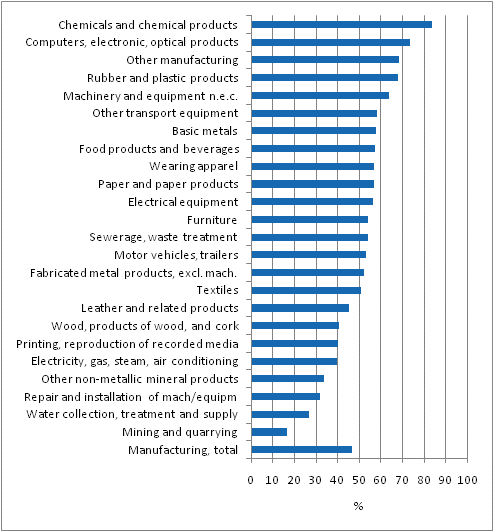
Prevalence of innovation activity by industry in services, 2006–2008, share of enterprises
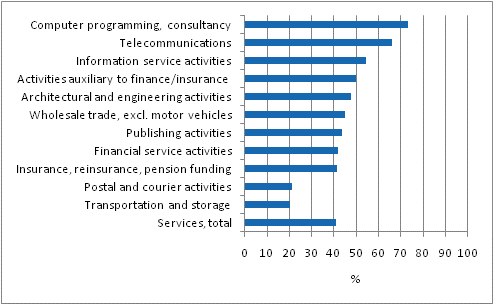
Introduction of product innovations and their share in enterprises’ turnover
Nearly one third of all enterprises reported having launched on the market a product innovation or innovations from 2006 to 2008. Enterprises having brought product innovations on the market accounted for 33 per cent in manufacturing and for 28 per cent in service enterprises.
In all, 22 per cent of the enterprises reported product innovations for a new or improved goods; in manufacturing 29 per cent and in services 15 per cent. Nearly one fifth of the enterprises, 17 per cent, had launched service innovations on the market; in manufacturing 14 per cent and in services 21 per cent. Almost one third of those having introduced product innovations reported both good and service innovations.
Product innovations are still mainly developed in the enterprise itself or in its group, because two thirds of those with innovations said the primary developer of innovations was their own enterprise or group.
Developers of product innovations by size category of personnel in manufacturing and services, 2006–2008, share of enterprises with product innovations
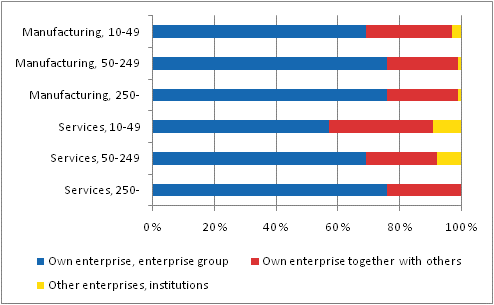
In all, 57 per cent of the enterprises with innovations had launched on the market such product innovations that were new to the market. Three fourths of the innovating enterprises reported innovations that were new only to their enterprise. Of all enterprises reporting product innovations, 43 per cent had brought on the market only such innovations that were new only to their own enterprise, 24 per cent had launched products only new to the market and 33 per cent reported products new both to their own enterprise and to the market.
In 2008 around 16 per cent of the enterprises' combined turnover was accumulated from innovations launched on the market in 2006 to 2008. In manufacturing, product innovations made up 21 per cent of the turnover and in services seven per cent. The turnover gained from new products in the market represented 40 per cent of the turnover accumulated from innovations.
Innovation activity connected to processes
Enterprises introduced process innovations slightly more often than product innovations in 2006 to 2008, because 34 per cent of all enterprises reported process innovations. In manufacturing 39 per cent had implemented process innovations. In services this share was 30 per cent.
Process innovations most often concerned manufacturing and production methods and supporting activities related to processes. Twenty-three per cent of the enterprises had adopted new manufacturing or production methods; in manufacturing 31 per cent and in services 14 per cent. Twenty-one per cent of enterprises had introduced innovations related to support activities; in manufacturing 21 per cent and in services 22 per cent. Twelve per cent of all enterprises reported innovations related to logistic solutions or delivery or distribution methods.
The developer of process innovations is often some other than the enterprise implementing them. Fifty-three per cent of those having introduced process innovations said the primary developer of innovations had been their enterprise or group, 37 per cent claimed it had been their enterprise with other actors and nine per cent said the primary developer of innovations had been other enterprises or institutions.
Developers of process innovations by size category of personnel in manufacturing and services, 2006–2008, share of enterprises with process innovations
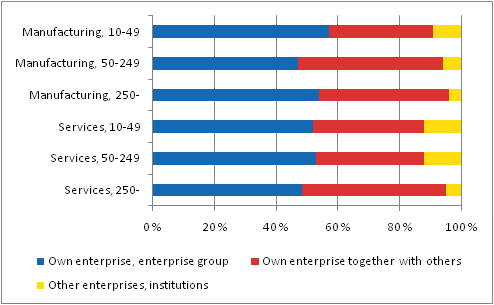
Interrupted and ongoing innovation projects
In 2006 to 2008 one quarter of all enterprises had had activities or projects aimed at development of product or process innovations, but they had either been interrupted during the review period or not been completed by the end of 2008. In manufacturing around 30 per cent of the enterprises had had these projects and in services about 20 per cent.
Almost all who said they had had such activities reported projects continuing at the end of 2008. Instead, good one third - ten per cent of all enterprises - reported projects that had been interrupted before their completion.
Innovation activities and expenditure
In addition to research and development, innovation activity includes purchasing of machinery and equipment, and acquisition of competence and training, when their specific objective is to develop or adopt product or process innovations. Innovation activities also comprise actions aimed at launching innovations on the market and other actions required for introducing innovations, such as various surveys, testing and technical preparation work.
Around three fourths of the enterprises having practised innovation activity related to product and process innovations in 2006 to 2008 said they had engaged in their own research and development (R&D). Slightly over one half of them said their R&D activity had been regular. About one half of those with innovation activity had commissioned R&D from outside the enterprise. In all, about 80 per cent of those having engaged in innovation activity reported R&D in 2006 to 2008, whether their own or commissioned from outside.
Seventy-five per cent of those with innovation activity reported having purchased machines, equipment, IT equipment and software for developing new or significantly improved products and processes. A total of 42 per cent of those with innovation activity had acquired enterprise-external competence, such as patents and non-patented inventions or know-how and other competence. Around 40 per cent had arranged or commissioned training related to innovation activity and 38 per cent reported actions related to launching innovations on the market. Similarly, 38 per cent of those with innovation activity had used other actions not mentioned above for adoption of innovations.
Enterprises reported innovation expenditure related to their own R&D, R&D commissioned from outside the enterprise, machine and equipment purchases and acquisition of knowledge connected to innovation activity to the tune of EUR seven billion in 2008. The expenditure on enterprises’ own R&D totalled about EUR 4.6 billion. Enterprises commissioned R&D from others at about EUR one billion. Machine and equipment purchases related to innovations amounted to nearly EUR 1.3 billion and acquisition of knowledge to nearly EUR 200 million.
In manufacturing the combined innovation expenditure of enterprises was nearly EUR 5.9 billion, and in the service industries included in the survey good EUR 1.1 billion.
Distribution of innovation expenditure in manufacturing, 2008
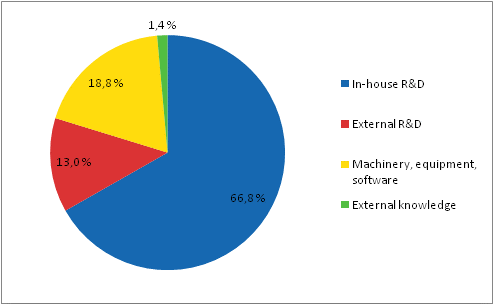
Distribution of innovation expenditure in services, 2008
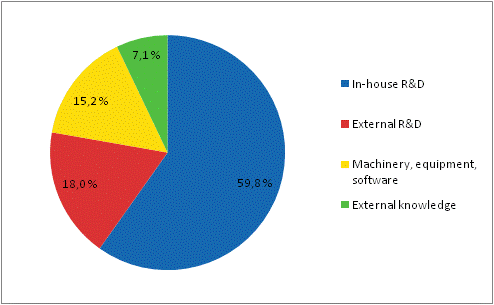
Around one third of the enterprises with innovation activity had received public funding for their activity in 2006 to 2008. In manufacturing 46 per cent had had funding, in services 20 per cent.
Eight per cent of those with innovation activity had received funding from local or regional authorities. Twenty-nine per cent had received support from the State and seven per cent from the European Union. Large enterprises received support from the State and the EU more often than small ones, while smaller enterprises got funding from local or regional authorities in relative terms more frequently than large ones did.
Information sources of innovation activity
One’s own enterprise or group is still the most significant information source for innovation activity; 96 per cent of those having engaged in innovations had used their own enterprise or group as the information source and 65 per cent assessed their own enterprise or concern as being the primary source.
The next most important information sources in 2006 to 2008 were customers and suppliers of equipment and materials. The significance of customers was mostly felt large or moderate, while equipment and material suppliers were most often mentioned as moderately important sources.
In relative terms, of the information sources mentioned the least use was made in 2006 to 2008 of public and private non-profit research institutes, universities and polytechnics and industrial organisations. The shares of those having used them as information sources were, respectively, 51, 59 and 64 per cent of those having engaged in innovation activity.
Use of different information sources and their significance appeared to be similar in manufacturing and services.
Co-operation in innovation activity
The key co-operation partners in innovation activity are customers and equipment and material suppliers and for group enterprises other enterprises in their group. Around one third of those with innovation activity connected to product or process innovations in 2006 to 2008 reported about co-operation with equipment and material suppliers. Similarly, around one third said they had had collaboration related to innovation activity with customers. Forty per cent of the innovating enterprises belonging to groups had co-operated with enterprises in their own group.
In relative terms, the least collaboration was reported with public and private non-profit research institutes. Majority of those that had co-operated with them said the importance of the collaboration had been minor.
Co-operation in innovation activities by co-operation partner, 2006–2008, share of enterprises with innovation activities
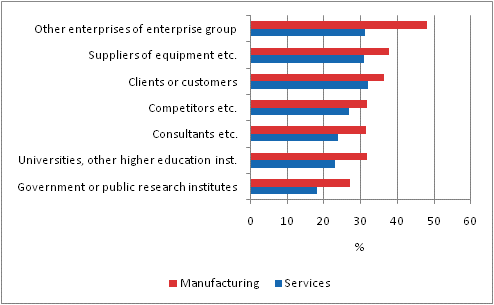
In all, 37 per cent of those with innovation activity said they had had co-operation related to innovations. Nearly all of these enterprises had co-operation partners in Finland, around 70 per cent elsewhere in Europe. Of those having co-operated, nearly one third had partners in the United States and close on one fifth said they had partners in China. Six per cent of those having co-operated reported partners in India and one fifth elsewhere not mentioned above.
Objectives of innovation activity
Improvement of the quality of products and enlargement of the product selection were mentioned relatively most often in the survey as the objectives of the innovation activity related to product and process innovations. Naturally one key objective is also to increase the market share.
Similarly, increasing the flexibility of production and improvement of efficiency are also central to the development of activity; around 90 per cent of the enterprises with innovation activity regarded these (improvement of flexibility and lowering of unit costs) as the targets of their innovation activity.
Source: Innovation 2008, Statistics Finland
Inquiries: Mervi Niemi (09) 1734 3263, tiede.teknologia@stat.fi
Director in charge: Leena Storg�rds
Updated 10.6.2010
Official Statistics of Finland (OSF):
Innovation [e-publication].
ISSN=1797-4399. 2008,
2. Innovation activity connected to product and process innovations in 2006–2008
. Helsinki: Statistics Finland [referred: 14.12.2025].
Access method: http://stat.fi/til/inn/2008/inn_2008_2010-06-10_kat_002_en.html

